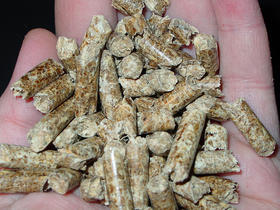Georgia’s Forests’ Leftovers Becoming A Major Source Of Renewable Energy

After a timber company makes its plywood or paper, there’s leftover sawdust and wood shavings. These leftovers are called woody biomass and in Georgia, they’re becoming a big source of renewable energy.
A Pew study ranked Georgia third in the country for converting this “woody biomass” into electricity.
Trees are a big deal here.
“We lead the nation in the production of telephone polls. We have the largest hardwood sawmill in the United States. We have the largest recycled paper mill in North America. We have the largest wood pellet plant in the world,” says Risher Willard with the Georgia Forestry Commission.
Georgia has the most acres of forest available for commercial use in the country: almost 25 million acres. That’s more than two-thirds of the state and more and more of our forests are becoming commercialized.
European Demand
That’s partly because Europeans want our wood.
“You’re talking about big facilities creating these really dense pellets, because Europe has these huge incentives – government incentives – for woody biomass right now in their efforts to cut their greenhouse gas emissions,” says F.G. Beauregard with the National Wildlife Federation.
In 2007, there were no wood pellet mills in Georgia. Today, there are 10.
Beauregard’s hopeful this will become a bigger source of clean energy for the state. She says the forest industry has done a good job regulating itself, but …
“At the same time we need to make sure we’re not mortgaging our natural systems and wildlife to do that,” Beauregard says. “We need to make sure we’re doing it sustainably.”
Industry Growth
Risher Willard, with the Georgia Forestry Commission, says the industry is actually planting more trees than they’re chopping down.
“Any time you have more forestry business that encourages landowners to maintain their forests rather than converting it to some other use, it is good, in my opinion,” Willard says.
In 2012, the forest industry generated nearly $29 billion for the state. It’s currently the second largest industry in Georgia.
9(MDAxODM0MDY4MDEyMTY4NDA3MzI3YjkzMw004))








